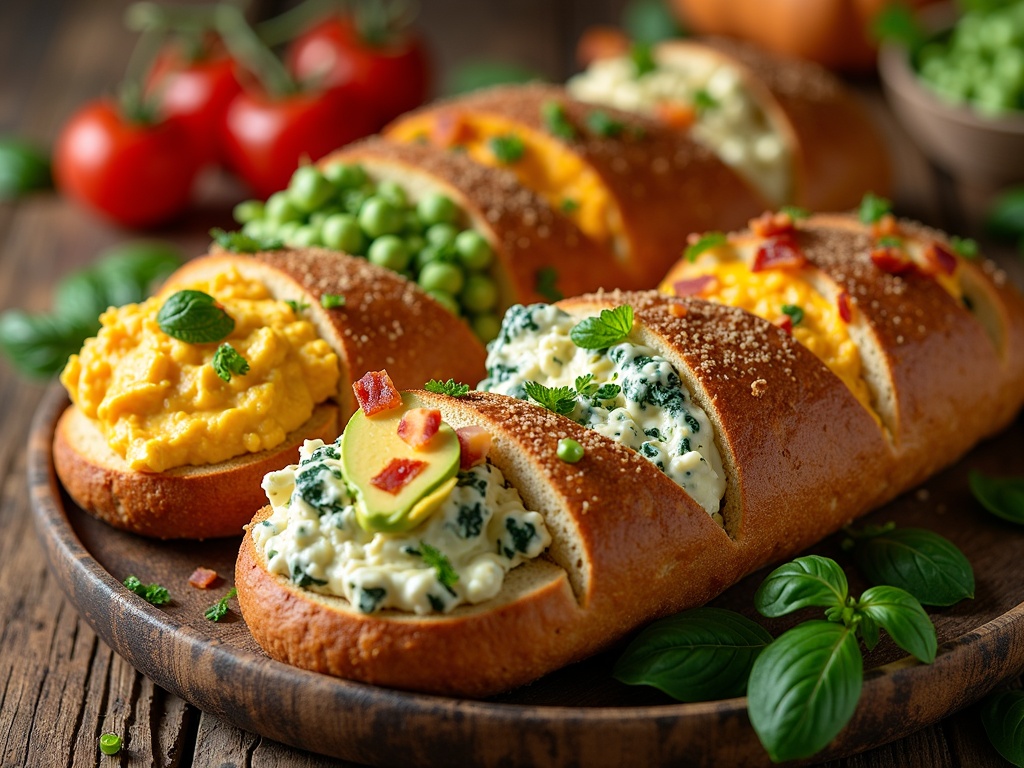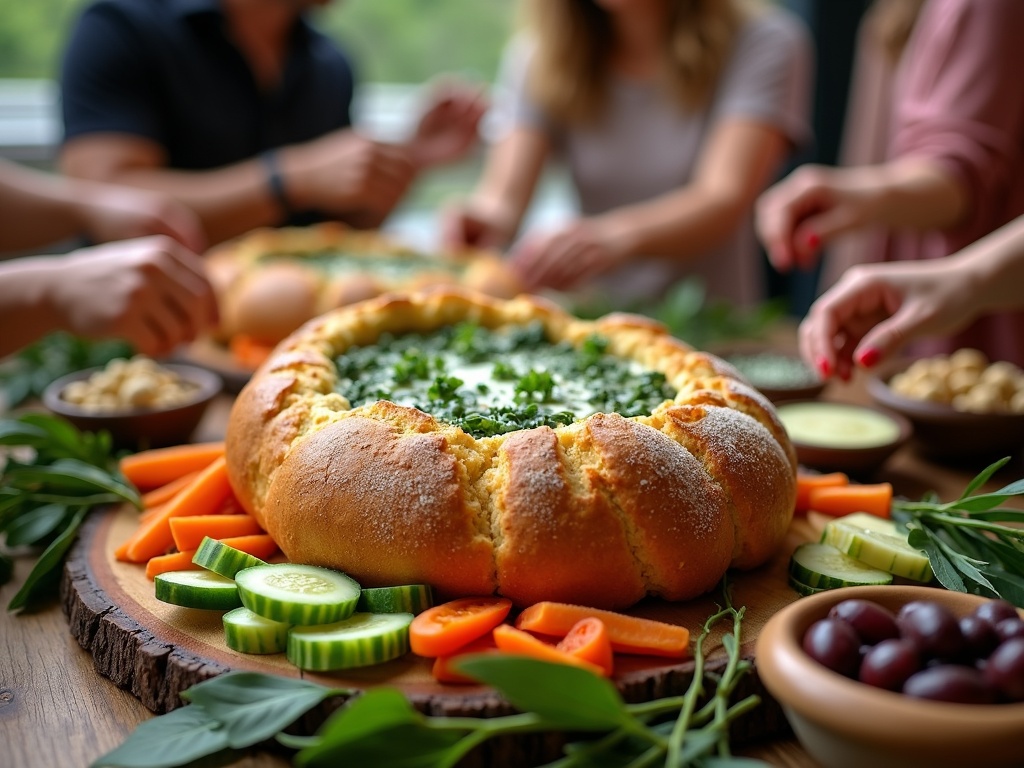Cob loaf has transformed from a traditional English bread into a favorite party centerpiece across Australia and New Zealand, with about 70% of Australians now serving it at social gatherings. This hollowed-out round, crusty bread filled with tasty dips creates an instant hit that enhances any gathering with its interactive, communal eating experience that naturally draws guests together.
Find In This Article
Key Takeaways
- A standard cob loaf typically serves 8-10 people and takes only 30-60 minutes to prepare, making it perfect for entertaining with little notice.
- Popular fillings include spinach and cheese (the gold standard), artichoke dip, cream cheese and onion, and nacho cheese, with each offering distinct flavor profiles.
- The traditional white bread cob loaf (500g) contains between 1300-1500 calories before adding fillings, with each serving of filling adding 200-600 additional calories.
- Healthier alternatives include using gluten-free or whole grain bread options and creating nutritious fillings with vegetables, legumes, and Greek yogurt.
- Presentation is crucial – serving on wooden boards with vegetable crudités, garnishes, and seasonal ingredients elevates the experience and encourages social interaction.
What Makes Cob Loaf a Party Favorite
Cob loaf has quickly become a staple at gatherings across Australia and New Zealand for good reason. I’ve found that this hollowed-out round, crusty bread filled with delicious dips or spreads creates an instant centerpiece that guests can’t resist. The beauty lies in its simplicity – a crusty exterior with a soft interior that’s removed to create the perfect edible bowl.
The Perfect Crowd-Pleaser
A standard cob loaf typically serves 8-10 people depending on its size, making it ideal for gatherings both large and small. The preparation is relatively quick, taking only 30-60 minutes total from start to finish, including the time to prepare your favorite filling. This efficiency makes it a go-to option when I’m entertaining without much notice.
The popularity of cob loaf has exploded in recent years, particularly in Australia where approximately 70% of Australians serve it at social gatherings. This trend is also reflected online, with the hashtag #cobloaf garnering over 25,000 social media mentions as people share their creative variations.
While its current fame is centered in the Southern Hemisphere, cob loaf actually originated in England, where the round, crusty bread has been a traditional baking staple for centuries. Australians and New Zealanders have simply perfected the art of transforming it into a communal dipping experience.
What I love most about serving cob loaf is the communal experience it creates. Guests naturally gather around, tearing off pieces of the crusty bread and dipping them into the warm filling. It’s impossible not to engage with others while enjoying this interactive appetizer. For a sweet variation that’s equally crowd-pleasing, you might enjoy trying my banana loaf recipe which offers a different but equally delightful shared experience.
The versatility of cob loaf also adds to its appeal. From spinach and cheese to buffalo chicken, the filling options are virtually endless, allowing me to customize it to match any occasion or crowd preference. This adaptability, combined with its visual impact and practical serving style, explains why cob loaf has rightfully earned its place as a modern party favorite.

Popular Fillings That Make It Special
The filling inside a cob loaf transforms it from a simple bread bowl into a showstopping centerpiece. I’ve discovered through years of experimentation that the right filling can make all the difference between an average appetizer and one that guests can’t stop talking about.
Classic Favorites That Never Disappoint
Spinach and cheese dip remains the gold standard of cob loaf fillings. The combination of wilted spinach, melted cheese, and creamy base creates a perfect harmony that pairs beautifully with the crusty bread. For best results, I use fresh spinach rather than frozen, as it maintains better texture and flavor.
Artichoke dip brings a sophisticated twist to the traditional cob loaf. The slight tanginess of artichokes cuts through the richness of cheese and cream, creating a balanced filling that appeals to those seeking something a bit different. Adding a touch of lemon zest elevates this filling to new heights.
Cream cheese and onion offers simplicity at its finest. The sweetness of caramelized onions against the smooth cream cheese creates a comforting combination that’s hard to resist. I like to add a splash of balsamic vinegar to the onions while caramelizing for an extra depth of flavor.
Nacho cheese dip turns the cob loaf into a crowd-pleasing party favorite. Combining melted cheese with jalapeños, tomatoes, and avocado creates a festive filling that’s perfect for game days or casual gatherings. For an authentic touch, I incorporate traditional Mexican spices like cumin and chili powder.
Making Your Fillings Extraordinary
Fresh ingredients play a crucial role in creating standout fillings. Using freshly grated cheese instead of pre-packaged varieties makes a noticeable difference in meltability and flavor. Similarly, fresh herbs like parsley, chives, or dill can transform even the simplest filling into something special.
The beauty of cob loaf fillings lies in their adaptability to seasonal ingredients:
- Spring: Incorporate fresh peas, mint, and feta for a bright, fresh filling
- Summer: Add ripe tomatoes, basil, and mozzarella for an Italian-inspired option
- Fall: Mix in roasted pumpkin, sage, and nutmeg for a cozy autumnal flavor
- Winter: Create a hearty filling with caramelized onions, bacon, and Swiss cheese
Homemade fillings offer significant advantages over store-bought alternatives. By making your own, you control the sodium content, avoid preservatives, and can customize the flavors to your exact preferences. I’ve found that making fillings from scratch takes only a few extra minutes but delivers vastly superior results.
For a lighter option that still delivers on flavor, try using Greek yogurt as a base instead of mayonnaise or sour cream. The tanginess complements savory fillings while reducing overall calories and fat content.
If you’re looking for more bread-based recipes, you might also enjoy my sweet banana loaf recipe that uses similar baking techniques.
The secret to truly exceptional cob loaf fillings is balancing textures and flavors. I always aim for something creamy, something with a bit of texture, and ingredients that provide both savory depth and bright notes. This combination ensures each bite offers a complete flavor experience that keeps everyone coming back for more.

Know Your Calories Before You Dig In
I’m all about enjoying good food, but it’s also smart to know what you’re consuming, especially when indulging in something as deliciously tempting as a cob loaf dip. This party favorite packs more calories than you might expect, so let’s break down what you’re really eating when you dig into this crowd-pleaser.
A traditional white bread cob loaf (500g) contains between 1300-1500 calories before you even add any fillings. That’s quite substantial when you consider that’s just the vessel for your dip! The bread alone could represent more than half of someone’s daily calorie needs.
Filling and Dip Calorie Breakdown
Each serving of filling adds significantly to the calorie count:
- Each filling portion typically adds 200-600 additional calories depending on ingredients
- A typical spinach and cheese dip serving contains about 150-250 calories
- That same serving includes approximately 10g of fat and 5g of protein
- Creamy dips with cheese, cream cheese, or sour cream base will be at the higher end of the calorie spectrum
- Dips that incorporate meats like chicken or beef will add extra protein but also additional calories
I find it helpful to think of the cob loaf as a shared dish rather than an individual portion. When entertaining, I cut smaller pieces of the bread bowl to help with portion control, which is particularly important for health-conscious guests.
If you’re watching your calorie intake but still want to enjoy this treat, consider focusing on eating more of the dip with vegetable sticks rather than the bread. You could also try making a smaller version with a dinner roll instead of a full-sized loaf, or even try a banana loaf recipe for a different twist that offers more nutritional benefits.
Remember that enjoying food is about balance. The occasional cob loaf at a party isn’t going to derail your health goals, but being aware of what you’re consuming helps you make informed choices. I believe that understanding the calorie content of what we eat empowers us to enjoy treats like cob loaf dip without unwanted surprises when it comes to our nutrition goals.
Making It Healthier Your Way
I’ve discovered multiple ways to create a healthier cob loaf that doesn’t compromise on flavor. The versatility of this party favorite allows for numerous adaptations to suit dietary requirements without losing its appeal.
Bread Alternatives for Dietary Needs
The traditional cob loaf can be swapped out for several healthier alternatives. If you’re gluten intolerant, most bakeries now offer gluten-free cob loaves that work perfectly for this dish. These specially formulated loaves maintain the crucial sturdy exterior while providing a safe option for those with celiac disease or gluten sensitivity.
Whole grain bread versions deliver a nutritional boost compared to white bread options. The additional fiber helps slow digestion, creating a more satisfying eating experience while adding a nutty depth of flavor. The robust texture of whole grain bread actually holds up exceptionally well when hollowed out and filled with dip.
This concept shares similarities with the American “bread bowl” idea, where a round loaf serves as an edible vessel for soups or dips. The key difference lies in how we Australians typically tear the removed bread into chunks for dipping, creating an interactive shared food experience.
Nutritious Filling Options
The filling presents another opportunity to boost the healthfulness of your cob loaf. Consider these vegetable-based dip alternatives:
- Roasted pumpkin and feta dip, which provides beta-carotene and calcium
- Beetroot and yogurt blend that offers antioxidants and probiotics
- Spinach and white bean mixture for iron and plant-based protein
- Avocado-based dips that deliver healthy fats and vitamins
I always recommend using fresh ingredients rather than pre-packaged mixes for superior nutritional value. Fresh herbs like dill, parsley, or cilantro bring brightness to any dip while providing additional micronutrients.
The beauty of the cob loaf lies in its customizability. You can easily adapt the ingredients to accommodate various dietary needs within your group. For dairy-free guests, coconut yogurt creates a creamy base similar to traditional cream cheese. Plant-based alternatives to the usual cheese components work surprisingly well, especially when combined with nutritional yeast for that savory umami flavor.
For those watching their sodium intake, I’ve found that amplifying herbs and spices while reducing salt creates deeply flavorful dips that don’t compromise on taste. Adding roasted garlic provides rich flavor without the need for excessive salt.
If you’re looking to increase the protein content, consider incorporating legume-based ingredients like chickpeas or white beans into your dip. These additions create a more nutritionally balanced dish that will keep guests satisfied longer.
The traditional cob loaf often features heavy dairy products, but lighter options like Greek yogurt can replace some or all of the cream cheese for a protein boost with less fat. This substitution works particularly well in banana loaf recipes and other sweet variations too.
Fresh vegetables for dipping instead of just bread chunks adds color, nutrients, and crunch to the experience. Cherry tomatoes, cucumber spears, bell pepper strips, and carrot sticks create a vibrant display around your masterpiece while offering guests lighter options.
By making thoughtful adjustments to both the bread and filling components, your cob loaf can transform from an occasional indulgence to a reasonably healthy option that still delivers on taste and presentation.
How to Serve It Right
I’ve found that cob loaf is an absolute showstopper at gatherings. This hollow bread bowl filled with delicious dip creates an instant centerpiece that guests gravitate toward. The interactive nature of tearing pieces from the bread and dipping them makes it perfect for social occasions.
Perfect for Casual Entertaining
Cob loaf dip works brilliantly at BBQs, birthday parties, and holiday celebrations. The beauty lies in its versatility and crowd-pleasing nature. I serve mine on a large wooden board with the torn bread pieces arranged around the loaf, creating an inviting display that encourages people to dig in. For larger gatherings, consider making two smaller cob loaves instead of one large one to place at different ends of the table.
When hosting casual events, I place the cob loaf in a central location where guests can easily access it from all sides. The communal aspect of sharing this dish creates a relaxed atmosphere and gets conversations flowing. It’s also practical as an apéritif since guests can help themselves while mingling.
Presentation and Seasonal Touches
Presentation makes all the difference when serving cob loaf. I recommend these approaches to elevate your cob loaf display:
- Surround the cob loaf with colorful vegetable crudités like cucumber, bell peppers, and carrots for extra dipping options
- Add small bowls of olives, pickles, or nuts to complement the dip
- Garnish the top with fresh herbs, cracked pepper, or a drizzle of olive oil
- Serve on a rustic wooden board or slate platter for an appealing contrast
Seasonal ingredients enhance both flavor and presentation. In summer, I incorporate fresh herbs and vegetables like basil and cherry tomatoes. During winter holidays, a festive loaf recipe with cranberries and chestnuts creates a warming comfort food. Fall cob loaves benefit from pumpkin and sage additions, while spring versions shine with fresh peas and mint.
The key to serving cob loaf right is creating an approachable, interactive food experience. I keep serving tools simple—just a few small knives for those who prefer not to tear with their hands. Remember that cob loaf is at its best when served warm, so timing your presentation for shortly after preparation ensures the perfect consistency for dipping.
Sources:
Daily Bread – “History of Bread: It’s More than Just Loaf”
Health Eating – “The Nutritional Content of Popular Party Dips”
Food Culture Journal – “Social Gatherings and Food Trends in Australia”

